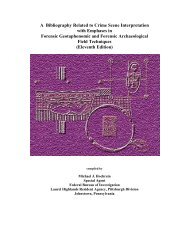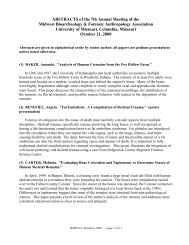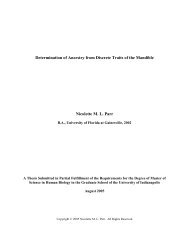Forensic Archeology Protocols Used by the University of Indianapolis
Forensic Archeology Protocols Used by the University of Indianapolis
Forensic Archeology Protocols Used by the University of Indianapolis
Create successful ePaper yourself
Turn your PDF publications into a flip-book with our unique Google optimized e-Paper software.
• Scraping should start in <strong>the</strong> more peripheral units, progressing inward towards <strong>the</strong> remains.<br />
• Similarly, scraping within a unit should start at its outside edge, moving inwards. This will ensure<br />
that hidden evidence is not kneeled on and that debris is not piled onto unexamined surfaces,<br />
fur<strong>the</strong>r burying evidence.<br />
• Screen each unit separately through 1/4" mesh, making sure to help <strong>the</strong> screeners keep track <strong>of</strong><br />
where each bucket came from.<br />
• Any evidence recovered during this stage is given an item number, bagged, and recorded in <strong>the</strong> log.<br />
• Establish a remote spot to dump screened refuse.<br />
• Make sure to keep an eye out for insect evidence, hair, and fibers.<br />
• When <strong>the</strong> grid is cleared, take photographs <strong>of</strong> all features and map in relevant boundaries.<br />
• Clear <strong>the</strong> entire grid before proceeding to Stage 3.<br />
(12) Stage 3: Excavate <strong>the</strong> remains<br />
• If <strong>the</strong> remains are not significantly buried (as for surface scatters), <strong>the</strong>n Stage 3 procedures are<br />
<strong>by</strong>passed.<br />
• If a burial mound is present, remove it in its entirety to <strong>the</strong> level <strong>of</strong> surrounding (undisturbed)<br />
ground surface before proceeding into <strong>the</strong> graveshaft.<br />
• Uncover <strong>the</strong> remains <strong>by</strong> removing all soil from within <strong>the</strong> burial feature.<br />
• If <strong>the</strong> position or depth <strong>of</strong> <strong>the</strong> remains is uncertain, a 15 x 15 cm window can be opened first.<br />
• Proceed <strong>by</strong> unit, and do not mix soil from different units (screen <strong>the</strong> material separately).<br />
• Work from <strong>the</strong> center towards <strong>the</strong> edges <strong>of</strong> <strong>the</strong> graveshaft, to preserve toolmarks.<br />
• Pedestal large objects on a tower <strong>of</strong> soil until <strong>the</strong>ir presence becomes unwieldy.<br />
• Small, shallow objects can be removed as <strong>the</strong>y are encountered if <strong>the</strong>y will get in <strong>the</strong> way.<br />
• Map and photograph <strong>the</strong> burial when <strong>the</strong> grave fill has been completely removed and <strong>the</strong> remains<br />
are completely exposed.<br />
• The undisturbed soil outside <strong>of</strong> <strong>the</strong> graveshaft should never be excavated unless <strong>the</strong> burial feature<br />
has been fully excavated first.<br />
• Always be alert for toolmarks in <strong>the</strong> walls <strong>of</strong> <strong>the</strong> graveshaft.<br />
(13) Stage 4: Collect <strong>the</strong> remains<br />
• A body still articulated with s<strong>of</strong>t tissues can be wrapped in a clean sheet and placed in a body bag.<br />
• Loose bones and o<strong>the</strong>r evidence should be bagged in paper sacks and transported in a large<br />
Rubbermaid container or in a body bag.<br />
(14) Stage 4: Collection <strong>of</strong> wide scatters using triangulation<br />
• For moderately-scattered evidence that is distributed no more than about 4 meters from <strong>the</strong><br />
baseline, a tape can be run <strong>of</strong>f <strong>of</strong> <strong>the</strong> baseline and eyeballed for perpendicularity. Record <strong>the</strong><br />
measurements from <strong>the</strong> stretched tape and on <strong>the</strong> baseline for your coordinate point.<br />
• It may be unwieldy to plot coordinate locations <strong>of</strong> evidence that is widely scattered, especially if a<br />
grid has not been constructed. Switch to triangular recording in <strong>the</strong>se cases as follows:<br />
• Use <strong>the</strong> 2 endstakes <strong>of</strong> <strong>the</strong> baseline as reference points. Make sure to record <strong>the</strong> distance between<br />
<strong>the</strong> stakes and record this value on <strong>the</strong> field data form.<br />
• Attach a long tape to each endstake and pull both tapes out to <strong>the</strong> evidence.<br />
• Record <strong>the</strong> 2 measurements, making sure to note which measurement came from which stake.<br />
• Record <strong>the</strong> direction from <strong>the</strong> baseline that <strong>the</strong> evidence lies (e.g., ei<strong>the</strong>r N or S <strong>of</strong> <strong>the</strong> baseline,<br />
since <strong>the</strong> tapes could be pulled in ei<strong>the</strong>r direction).<br />
<strong>Forensic</strong> <strong>Archeology</strong> <strong>Protocols</strong> -- page 4 <strong>of</strong> 7








